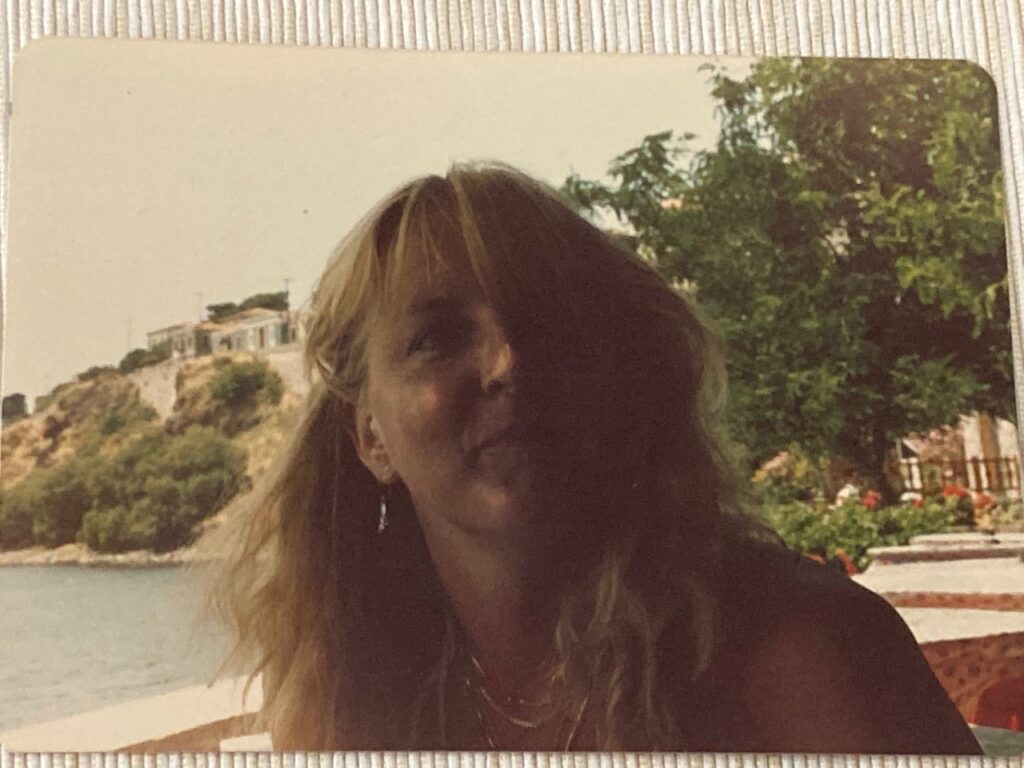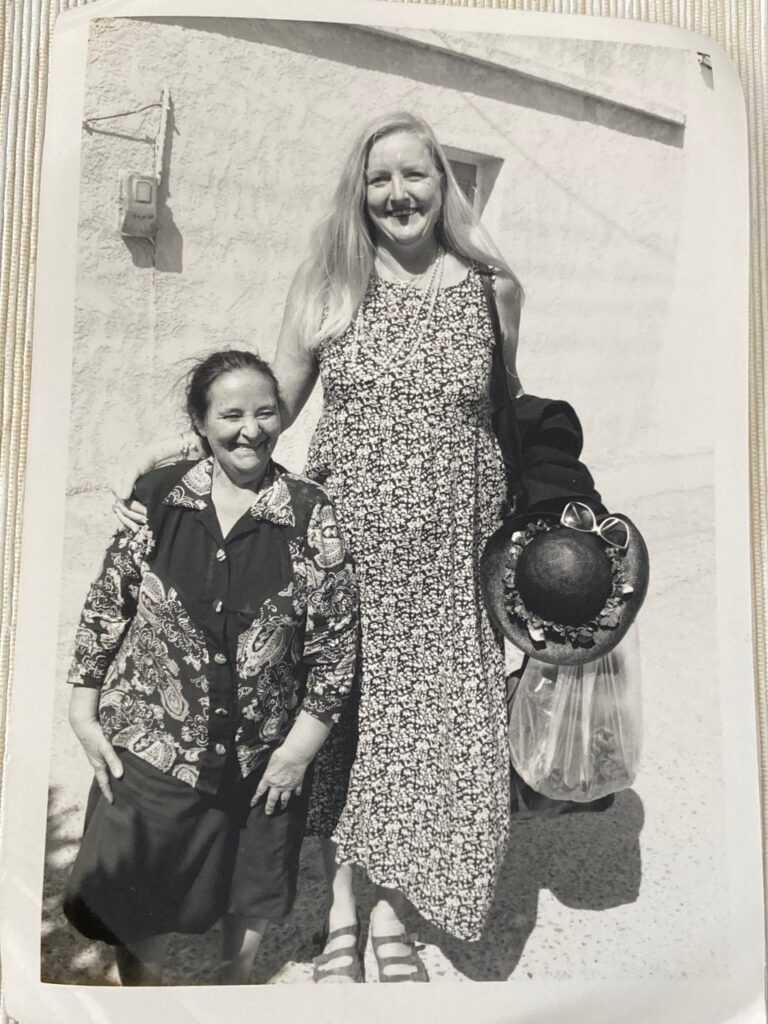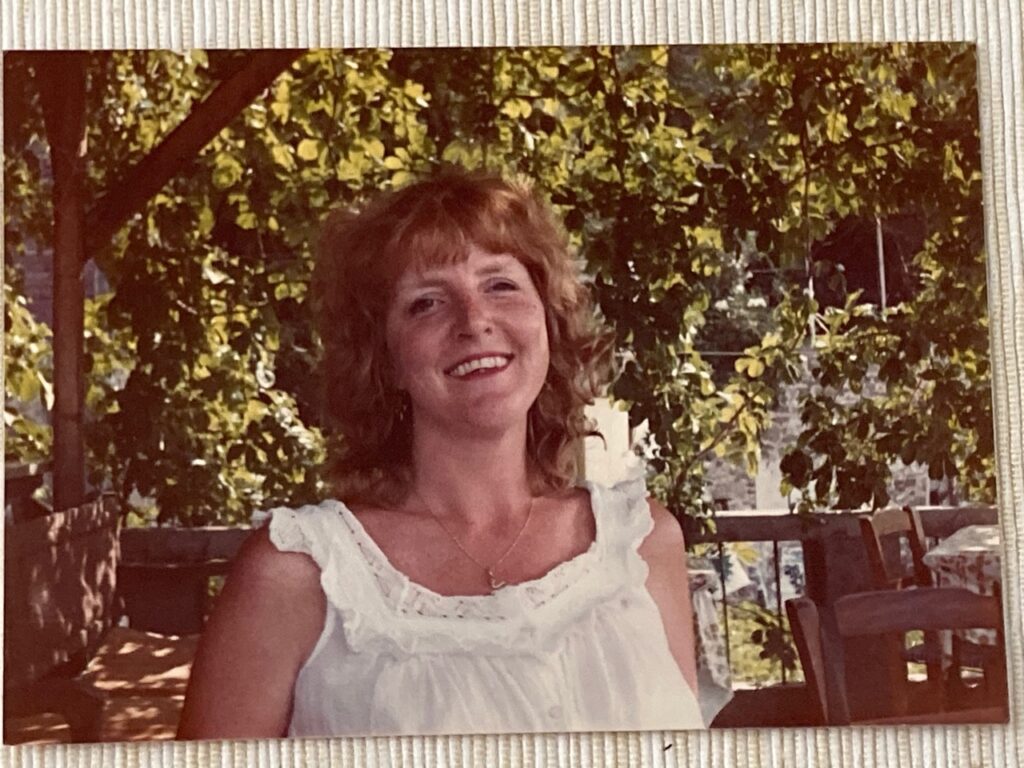
In the late ’90s, I rented a summer house in Molivos, Lesbos, to spend time with Carol Christ, the late feminist theologian. Carol was the rebellious scholar who challenged the world of religious thought, and with her help, I was writing a novel about embodied spirituality.
Of all the moments during those hot Greek summers, the long taxi ride with my daughter Sam to my house in Molivos has stayed with me. Our giddy astonishment as the cab sped up and down and over the round, wooded mountains, passing through nameless villages, and hot springs, traversing small plains and olive groves that must have been there since the days of Homer.
As we passed the Salt Pans of Kalloni, my daughter turned to me with a worried look: “Tell me about your friend Carol Christ,” she said. “Do you think her philosophy will help me?”
I said yes. I’d enrolled my daughter (as well as myself) in the workshops Carol ran in Lesbos. Carol’s workshops were a zesty mix of religious myths and history; poetry by Sappho, re-created rituals based on the Minoans and a great deal of hearty Greek cooking.
The workshops could be therapeutic and my daughter had been depressed. She had dropped out of McGill University, my alma mater, because she felt unhappy. A psychologist once told me once boys act out immediately when their parents divorce while girls don’t express their anger until they are in their 20s. That day in the taxi, Sam was 24, the same age I was when I married her father, and she was angry with me about her childhood.
As we rode in the cab to Molivos, she pressed me to tell her what my friend had to offer. It’s never wise to talk up your spiritual philosophy in case it’s conflated with proselytizing. And goddess spirituality is often dismissed as groups of flaky women messing around with spiritual precepts despite the now 50-year history of feminist studies on the sacred feminine.

In the taxi, I told my daughter about Carol who called herself by her Greek name, Karolina. Carol was born in Pasadena, Calif., on December 20, 1945. Her father John Anthony Christ was the co-owner of an insurance agency and her mother Janet Claire Christ was a 1950s housewife. Carol grew up in Covina, Calif., a city 22 miles east of Los Angeles. She graduated from Covina High School and gave the valedictorian address. Her high school grades convinced her parents to send her to Stanford University from 1963 to 1967.
In graduate studies at Yale, she became a feminist. One professor told her pointedly that female students weren’t expected to get Ph.D.’s. She had majored in religious studies because she wanted to understand the death of her baby brother when she was 13.
Carol was younger, blonder and taller than almost all the men in her class. They talked constantly about her miniskirts and long blonde hair and took bets on where she might sit in the classroom. The overwhelming male attention flustered Carol, whose parents were conservative Republicans. She felt frustrated at being perceived in terms of her body instead of her mind.
“Whether I wanted to or not,” she wrote in her book, She Who Changes: Re-Imagining the Divine in the World, “I was forced to think about the relation of mind and body and about the mistakes philosophers and theologians made when they wrote about women.”
She Who Changes is one of her 10 books of scholarship outlining her “theaology,” as she called her pioneering religious philosophy.
In 1978, Carol gave her famous speech at a conference at the University of Santa Cruz, Why Women Need the Goddess. That speech was reprinted in her book, Womanspirit Rising and has been widely anthologized.
In the ‘80s, Carol left her tenured teaching position in California because she was told her views meant she wouldn’t be hired at a major American university. So she moved to Greece where started the Ariadne Institute for the Study of Myth and Ritual. It runs pilgrimages to Minoan shrines in Crete, and her work is still seen by many scholars as outside the academic mainstream.
In September 1995, I went on one of Carol’s Minoan pilgrimages. I was skeptical of a peaceful matriarchal society in prehistory. It seemed too easy to project onto Neolithic cultures the longing for values we lack in the present. Carol was also unsure about me. I was a professional writer. What if I wrote a negative review of her work?

Carol was my height, six-foot-two, with a commanding air that hid her shyness. At the time of the Minoan tour, she had long blonde hair and so did I. She was also pretty, with a dainty, doll-like face and a long, curvaceous body that she clothed in gold jewelry and elegant feminine scarves and dresses. She could have been the Amazonian teacher who protects her students in a girls’ school movie. My look at the time was a scruffier version.
Our mutual wariness soon dissolved. The year before she died, she wrote me about what our friendship had meant for her:
“Though I knew that I was a head taller than many of my friends, I literally had no idea how I looked in the world because there was no one to whom I could compare myself. Since almost everyone else sees someone who is about her height, weight, and coloring every day, it is hard for others to imagine how strange it makes you feel not ever to see anyone who looks like you…”

The first afternoon at the Palace of Knossos, Carol told us human sacrifice and war were unknown in the so-called Minoan period which begins at 3000 BCE. She debunked the tourist guides claiming Knossos had been ruled by a king with a large navy. The guides were influenced by the work of Sir Arthur Evans, the British archeologist who believed Knossos was ruled by King Minos, even though King Minos lived in an historical time after Minoan culture. Carol also said Evans had been wrong to claim an image on a fresco of a white-faced aristocratic youth was their king since the Minoans painted their female figures with white skin and the men’s skin brown.
According to Carol, the enchanting images of the dark-haired snake goddesses represented priestesses who stood in for the Goddess. The space Evans called the throne room had likely been a shrine complex designed to celebrate the harvest cycles.
Carol referred to the work of Marija Gimbutas, the late Lithuanian-American archeologist who believed it’s wrong to call Paleolithic and Neolithic images, ‘fertility goddesses.’ According to Gimbutas, the goddesses in old European cultures had meaning beyond their sexuality. They represented the metaphysical power of the universe at its deepest level and she compiled a detailed inventory of over 2,000 Bronze Age artifacts in her book, The Language of the Goddess. In his introduction to her book, Joseph Campbell compared Gimbutas’s scholarship to the work of French scholar Jean-Francois Champollion who deciphered the Rosetta Stone.
That afternoon in the ruins of Knossos we saw no glorified military frescoes or a depiction of an armed king, and I began to be less concerned over whether Minoan society was a goddess worshiping culture. Often Westerners like myself have trouble imagining a peaceful, artistic society.
On the two week pilgrimage, we visited Minoan shrines like Gournia, Phaistos, Zaros, Myrtos and Malia, including the Skoteino cave where Carol and our group called out the names of our female ancestors. (Few of us could go back more than a generation or two.) At Zakros, exhausted by my cold, I told Carol I needed to sleep in the bus, and I walked away, holding up my arms up in the same posture as the snake goddesses, elbows bent, palms out to release the healing energy in my palms.
Look, she’s processing like a snake goddess, one of the women joked. Everyone laughed. I turned around, laughing myself, and saw clusters of tiny bright orange flames hovering in front of each woman’s chest. My vision lasted for about thirty seconds.
The sight evoked Sunday school stories about Jesus’ disciples receiving the Holy Spirit after his resurrection. No longer a practicing Anglican, I was baffled by the tiny flames burning in front of the women’s chests. Carol had no scientific explanation although she believed such experiences are part of a non-rational way of understanding spirituality.
My daughter liked the story about my vision, but her attention was drifting when I tried to explain that the most radical part of Carol’s theology wasn’t her belief that egalitarian matriarchies in Neolithic societies worshiped a female deity.
It was Carol’s belief in embodied spirituality, a philosophical position shared by some contemporary female and a few male scholars like Charles Hartshorne. Christian religion, with its traditional focus on a heaven after death, emphasizes the relief that comes from leaving behind physical reality. But according to Carol, the body is the portal to religious experience.
Don’t try to escape your body, she said. Inhabit it.

In the last two decades of her life, Carol Christ turned to process philosophy for inspiration. In her later books, she described how she came to believe all ethnic groups and all gender identities, including non-binary people, represent the godhead.
My daughter nodded and seemed interested, but by then our taxi had started climbing the Molivos hill to where Carol stood waiting to greet us in her traditional stone house.
On July 14, 2021, Carol Christ died of cancer in Heraklion, Crete. Her 2022 Goddess Pilgrimage to Crete will go ahead despite financial pressures. Her Molivos workshop in the summer of 1997 turned out to be a rewarding experience for my daughter and me. I went on to write more books and marry my common law partner. My daughter runs a successful Canadian literary agency and is married with two children.
Not long after my daughter and I returned from Greece, I published a poem about the experience. Here’s an excerpt from the poem, Sappho’s Women:
I greet you like the last sweet dish of olives at my evening meal waiting dark and round in the soft-flowing twilight
life passes life passes
lovely golden child of mine – don't go where I can't sing to you with a mother's honeyed tongue!
Karolina – long-limbed golden woman when the two of us walk by the shore the tall grasses tremble and our laughter floats across the wave-wrinkled sea to Turkey's mulberry coast leaving us forlorn
life passes life passes
Rest in power, Carol Christ.
Up next:





